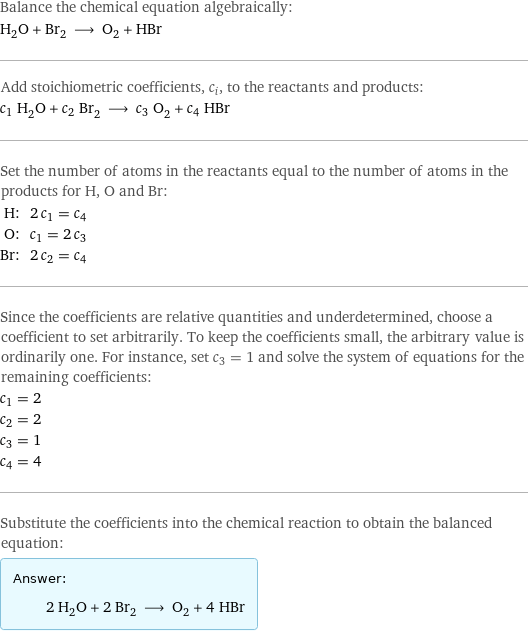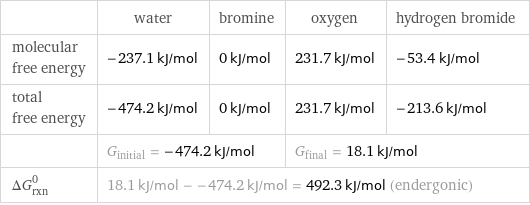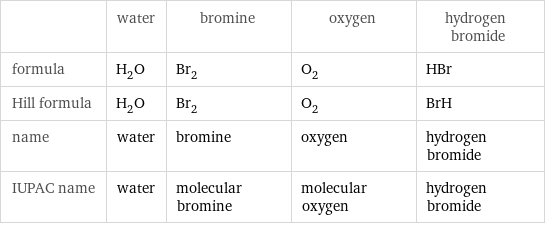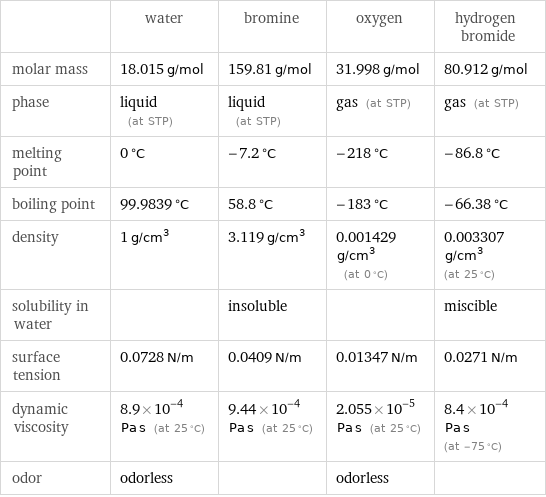Input interpretation

H_2O water + Br_2 bromine ⟶ O_2 oxygen + HBr hydrogen bromide
Balanced equation

Balance the chemical equation algebraically: H_2O + Br_2 ⟶ O_2 + HBr Add stoichiometric coefficients, c_i, to the reactants and products: c_1 H_2O + c_2 Br_2 ⟶ c_3 O_2 + c_4 HBr Set the number of atoms in the reactants equal to the number of atoms in the products for H, O and Br: H: | 2 c_1 = c_4 O: | c_1 = 2 c_3 Br: | 2 c_2 = c_4 Since the coefficients are relative quantities and underdetermined, choose a coefficient to set arbitrarily. To keep the coefficients small, the arbitrary value is ordinarily one. For instance, set c_3 = 1 and solve the system of equations for the remaining coefficients: c_1 = 2 c_2 = 2 c_3 = 1 c_4 = 4 Substitute the coefficients into the chemical reaction to obtain the balanced equation: Answer: | | 2 H_2O + 2 Br_2 ⟶ O_2 + 4 HBr
Structures

+ ⟶ +
Names

water + bromine ⟶ oxygen + hydrogen bromide
Reaction thermodynamics
Enthalpy

| water | bromine | oxygen | hydrogen bromide molecular enthalpy | -285.8 kJ/mol | 0 kJ/mol | 0 kJ/mol | -36.3 kJ/mol total enthalpy | -571.7 kJ/mol | 0 kJ/mol | 0 kJ/mol | -145.2 kJ/mol | H_initial = -571.7 kJ/mol | | H_final = -145.2 kJ/mol | ΔH_rxn^0 | -145.2 kJ/mol - -571.7 kJ/mol = 426.5 kJ/mol (endothermic) | | |
Gibbs free energy

| water | bromine | oxygen | hydrogen bromide molecular free energy | -237.1 kJ/mol | 0 kJ/mol | 231.7 kJ/mol | -53.4 kJ/mol total free energy | -474.2 kJ/mol | 0 kJ/mol | 231.7 kJ/mol | -213.6 kJ/mol | G_initial = -474.2 kJ/mol | | G_final = 18.1 kJ/mol | ΔG_rxn^0 | 18.1 kJ/mol - -474.2 kJ/mol = 492.3 kJ/mol (endergonic) | | |
Entropy

| water | bromine | oxygen | hydrogen bromide molecular entropy | 69.91 J/(mol K) | 152.2 J/(mol K) | 205 J/(mol K) | 199 J/(mol K) total entropy | 139.8 J/(mol K) | 304.5 J/(mol K) | 205 J/(mol K) | 796 J/(mol K) | S_initial = 444.3 J/(mol K) | | S_final = 1001 J/(mol K) | ΔS_rxn^0 | 1001 J/(mol K) - 444.3 J/(mol K) = 556.7 J/(mol K) (endoentropic) | | |
Equilibrium constant
![Construct the equilibrium constant, K, expression for: H_2O + Br_2 ⟶ O_2 + HBr Plan: • Balance the chemical equation. • Determine the stoichiometric numbers. • Assemble the activity expression for each chemical species. • Use the activity expressions to build the equilibrium constant expression. Write the balanced chemical equation: 2 H_2O + 2 Br_2 ⟶ O_2 + 4 HBr Assign stoichiometric numbers, ν_i, using the stoichiometric coefficients, c_i, from the balanced chemical equation in the following manner: ν_i = -c_i for reactants and ν_i = c_i for products: chemical species | c_i | ν_i H_2O | 2 | -2 Br_2 | 2 | -2 O_2 | 1 | 1 HBr | 4 | 4 Assemble the activity expressions accounting for the state of matter and ν_i: chemical species | c_i | ν_i | activity expression H_2O | 2 | -2 | ([H2O])^(-2) Br_2 | 2 | -2 | ([Br2])^(-2) O_2 | 1 | 1 | [O2] HBr | 4 | 4 | ([HBr])^4 The equilibrium constant symbol in the concentration basis is: K_c Mulitply the activity expressions to arrive at the K_c expression: Answer: | | K_c = ([H2O])^(-2) ([Br2])^(-2) [O2] ([HBr])^4 = ([O2] ([HBr])^4)/(([H2O])^2 ([Br2])^2)](../image_source/0c8e8b483dc552278bbce922cbe08032.png)
Construct the equilibrium constant, K, expression for: H_2O + Br_2 ⟶ O_2 + HBr Plan: • Balance the chemical equation. • Determine the stoichiometric numbers. • Assemble the activity expression for each chemical species. • Use the activity expressions to build the equilibrium constant expression. Write the balanced chemical equation: 2 H_2O + 2 Br_2 ⟶ O_2 + 4 HBr Assign stoichiometric numbers, ν_i, using the stoichiometric coefficients, c_i, from the balanced chemical equation in the following manner: ν_i = -c_i for reactants and ν_i = c_i for products: chemical species | c_i | ν_i H_2O | 2 | -2 Br_2 | 2 | -2 O_2 | 1 | 1 HBr | 4 | 4 Assemble the activity expressions accounting for the state of matter and ν_i: chemical species | c_i | ν_i | activity expression H_2O | 2 | -2 | ([H2O])^(-2) Br_2 | 2 | -2 | ([Br2])^(-2) O_2 | 1 | 1 | [O2] HBr | 4 | 4 | ([HBr])^4 The equilibrium constant symbol in the concentration basis is: K_c Mulitply the activity expressions to arrive at the K_c expression: Answer: | | K_c = ([H2O])^(-2) ([Br2])^(-2) [O2] ([HBr])^4 = ([O2] ([HBr])^4)/(([H2O])^2 ([Br2])^2)
Rate of reaction
![Construct the rate of reaction expression for: H_2O + Br_2 ⟶ O_2 + HBr Plan: • Balance the chemical equation. • Determine the stoichiometric numbers. • Assemble the rate term for each chemical species. • Write the rate of reaction expression. Write the balanced chemical equation: 2 H_2O + 2 Br_2 ⟶ O_2 + 4 HBr Assign stoichiometric numbers, ν_i, using the stoichiometric coefficients, c_i, from the balanced chemical equation in the following manner: ν_i = -c_i for reactants and ν_i = c_i for products: chemical species | c_i | ν_i H_2O | 2 | -2 Br_2 | 2 | -2 O_2 | 1 | 1 HBr | 4 | 4 The rate term for each chemical species, B_i, is 1/ν_i(Δ[B_i])/(Δt) where [B_i] is the amount concentration and t is time: chemical species | c_i | ν_i | rate term H_2O | 2 | -2 | -1/2 (Δ[H2O])/(Δt) Br_2 | 2 | -2 | -1/2 (Δ[Br2])/(Δt) O_2 | 1 | 1 | (Δ[O2])/(Δt) HBr | 4 | 4 | 1/4 (Δ[HBr])/(Δt) (for infinitesimal rate of change, replace Δ with d) Set the rate terms equal to each other to arrive at the rate expression: Answer: | | rate = -1/2 (Δ[H2O])/(Δt) = -1/2 (Δ[Br2])/(Δt) = (Δ[O2])/(Δt) = 1/4 (Δ[HBr])/(Δt) (assuming constant volume and no accumulation of intermediates or side products)](../image_source/bdc1066bdf93f4e10a94026304cd08b9.png)
Construct the rate of reaction expression for: H_2O + Br_2 ⟶ O_2 + HBr Plan: • Balance the chemical equation. • Determine the stoichiometric numbers. • Assemble the rate term for each chemical species. • Write the rate of reaction expression. Write the balanced chemical equation: 2 H_2O + 2 Br_2 ⟶ O_2 + 4 HBr Assign stoichiometric numbers, ν_i, using the stoichiometric coefficients, c_i, from the balanced chemical equation in the following manner: ν_i = -c_i for reactants and ν_i = c_i for products: chemical species | c_i | ν_i H_2O | 2 | -2 Br_2 | 2 | -2 O_2 | 1 | 1 HBr | 4 | 4 The rate term for each chemical species, B_i, is 1/ν_i(Δ[B_i])/(Δt) where [B_i] is the amount concentration and t is time: chemical species | c_i | ν_i | rate term H_2O | 2 | -2 | -1/2 (Δ[H2O])/(Δt) Br_2 | 2 | -2 | -1/2 (Δ[Br2])/(Δt) O_2 | 1 | 1 | (Δ[O2])/(Δt) HBr | 4 | 4 | 1/4 (Δ[HBr])/(Δt) (for infinitesimal rate of change, replace Δ with d) Set the rate terms equal to each other to arrive at the rate expression: Answer: | | rate = -1/2 (Δ[H2O])/(Δt) = -1/2 (Δ[Br2])/(Δt) = (Δ[O2])/(Δt) = 1/4 (Δ[HBr])/(Δt) (assuming constant volume and no accumulation of intermediates or side products)
Chemical names and formulas

| water | bromine | oxygen | hydrogen bromide formula | H_2O | Br_2 | O_2 | HBr Hill formula | H_2O | Br_2 | O_2 | BrH name | water | bromine | oxygen | hydrogen bromide IUPAC name | water | molecular bromine | molecular oxygen | hydrogen bromide
Substance properties

| water | bromine | oxygen | hydrogen bromide molar mass | 18.015 g/mol | 159.81 g/mol | 31.998 g/mol | 80.912 g/mol phase | liquid (at STP) | liquid (at STP) | gas (at STP) | gas (at STP) melting point | 0 °C | -7.2 °C | -218 °C | -86.8 °C boiling point | 99.9839 °C | 58.8 °C | -183 °C | -66.38 °C density | 1 g/cm^3 | 3.119 g/cm^3 | 0.001429 g/cm^3 (at 0 °C) | 0.003307 g/cm^3 (at 25 °C) solubility in water | | insoluble | | miscible surface tension | 0.0728 N/m | 0.0409 N/m | 0.01347 N/m | 0.0271 N/m dynamic viscosity | 8.9×10^-4 Pa s (at 25 °C) | 9.44×10^-4 Pa s (at 25 °C) | 2.055×10^-5 Pa s (at 25 °C) | 8.4×10^-4 Pa s (at -75 °C) odor | odorless | | odorless |
Units
